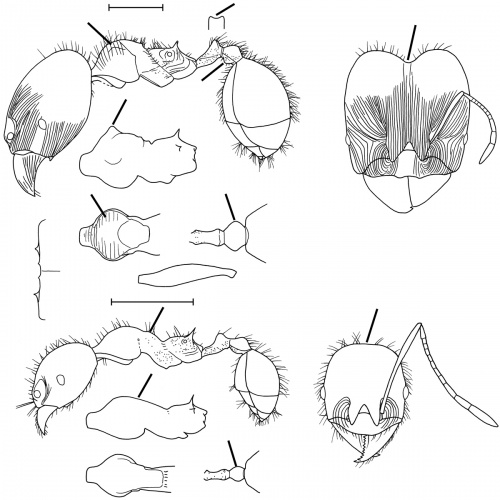Pheidole auropilosa
| Pheidole auropilosa | |
|---|---|

| |
| Scientific classification | |
| Kingdom: | Animalia |
| Phylum: | Arthropoda |
| Class: | Insecta |
| Order: | Hymenoptera |
| Family: | Formicidae |
| Subfamily: | Myrmicinae |
| Tribe: | Attini |
| Genus: | Pheidole |
| Species: | P. auropilosa |
| Binomial name | |
| Pheidole auropilosa Mayr, 1887 | |
Nothing is known about the biology of auropilosa.
Identification
See the description in the nomenclature section.
Keys including this Species
Distribution
Southeastern Brazil, from Espírito Santo south to Rio Grande do Sul, and Misiones, Argentina. (Wilson 2003)
Latitudinal Distribution Pattern
Latitudinal Range: -16.0667° to -30.0333°.
| North Temperate |
North Subtropical |
Tropical | South Subtropical |
South Temperate |
- Source: AntMaps
Distribution based on Regional Taxon Lists
Neotropical Region: Argentina, Brazil (type locality), Paraguay.
Distribution based on AntMaps
Distribution based on AntWeb specimens
Check data from AntWeb
Countries Occupied
| Number of countries occupied by this species based on AntWiki Regional Taxon Lists. In general, fewer countries occupied indicates a narrower range, while more countries indicates a more widespread species. |

|
Estimated Abundance
| Relative abundance based on number of AntMaps records per species (this species within the purple bar). Fewer records (to the left) indicates a less abundant/encountered species while more records (to the right) indicates more abundant/encountered species. |

|
Biology
Castes
Worker
Minor
Images from AntWeb
   
| |
| Syntype of Pheidole auropilosa. Worker. Specimen code casent0901564. Photographer Will Ericson, uploaded by California Academy of Sciences. | Owned by NHMUK, London, UK. |
Nomenclature
The following information is derived from Barry Bolton's Online Catalogue of the Ants of the World.
- auropilosa. Pheidole auropilosa Mayr, 1887: 596 (s.), 606 (w.), 608 (q.m.) BRAZIL. See also: Wilson, 2003: 658.
Unless otherwise noted the text for the remainder of this section is reported from the publication that includes the original description.
Description
From Wilson (2003): DIAGNOSIS A very large, yellow member of the tristis group strongly distinguished by the following traits.
Major: humerus seen in dorsal-oblique view very prominent, bluntly right-angular; a convex process extrudes from center of postpetiolar venter in side view; postpetiolar node diamond-shaped from above; anterior two-thirds of dorsal surface of head densely covered by longitudinal carinulae, those originating from the anterior margin of the lateral clypeal border curving outward toward the eye and those originating from the posterior frontal carinae traveling to the sides of the head.
Minor: occipital border broad, lacking nuchal collar; postpetiole diamond-shaped from above.
MEASUREMENTS (mm) Lectotype major: HW 2.06, HL 2.06, SL 1.10, EL 0.22, PW 0.86. Paralectotype minor: HW 0.84, HL 0.84, SL 1.04, EL 0.14, PW 0.52.
COLOR Major: body light reddish yellow, shaded slightly darker on the gaster.
Minor: concolorous dark yellow.
Figure. Upper: lectotype, major. Lower: paralectotype, minor. Scale bars = 1 mm.
Type Material
BRAZIL: Santa Catarina. Naturhistorisches Museum Wien, Vienna - as reported in Wilson (2003)
Etymology
L auropilosa, golden (yellow) hair. (Wilson 2003)
References
- Mayr, G. 1887. Südamerikanische Formiciden. Verh. K-K. Zool.-Bot. Ges. Wien 37: 511-632 (page 596, 606, 608, soldier described, worker described, queen, male described)
- Wilson, E. O. 2003. Pheidole in the New World: A dominant, hyperdiverse ant genus. Harvard University Press, Cambridge, MA. (page 658, fig. major, minor described)
References based on Global Ant Biodiversity Informatics
- Brandao, C.R.F. 1991. Adendos ao catalogo abreviado das formigas da regiao neotropical (Hymenoptera: Formicidae). Rev. Bras. Entomol. 35: 319-412.
- Bruch C. 1914. Catálogo sistemático de los formícidos argentinos. Revista del Museo de La Plata 19: 211-234.
- Emery C. 1906. Studi sulle formiche della fauna neotropica. XXVI. Bullettino della Società Entomologica Italiana 37: 107-194.
- Favretto M. A., E. Bortolon dos Santos, and C. J. Geuster. 2013. Entomofauna from West of Santa Catarina State, South of Brazil. EntomoBrasilis 6 (1): 42-63.
- Kempf, W.W. 1972. Catalago abreviado das formigas da regiao Neotropical (Hym. Formicidae) Studia Entomologica 15(1-4).
- Kusnezov N. 1952. El género Pheidole en la Argentina (Hymenoptera, Formicidae). Acta Zoologica Lilloana 12: 5-88.
- Kusnezov N. 1978. Hormigas argentinas: clave para su identificación. Miscelánea. Instituto Miguel Lillo 61:1-147 + 28 pl.
- Luederwaldt H. 1918. Notas myrmecologicas. Rev. Mus. Paul. 10: 29-64.
- Menozzi C. 1926. Neue Ameisen aus Brasilien. Zoologischer Anzeiger. 69: 68-72.
- Rosa da Silva R. 1999. Formigas (Hymenoptera: Formicidae) do oeste de Santa Catarina: historico das coletas e lista atualizada das especies do Estado de Santa Catarina. Biotemas 12(2): 75-100.
- Santschi F. 1933. Fourmis de la République Argentine en particulier du territoire de Misiones. Anales de la Sociedad Cientifica Argentina. 116: 105-124.
- Ulyssea M.A., C. E. Cereto, F. B. Rosumek, R. R. Silva, and B. C. Lopes. 2011. Updated list of ant species (Hymenoptera, Formicidae) recorded in Santa Catarina State, southern Brazil, with a discussion of research advances and priorities. Revista Brasileira de Entomologia 55(4): 603-611.
- Wild, A. L. "A catalogue of the ants of Paraguay (Hymenoptera: Formicidae)." Zootaxa 1622 (2007): 1-55.



